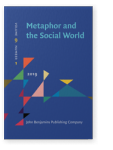Figurative analogies and how they are resisted in British Public Bill Committee debates
This paper studies metaphor use in British Public Bill Committee debates. It focuses on the way in which
legislators frame their arguments in metaphorical terms under the form of figurative analogies. Because these figurative analogies
can be misleading by oversimplifying the issue under discussion, resisting them by putting forward counter-argumentation is a
crucial and necessary skill. The purpose of this paper is to explore the phenomenon of countering figurative analogies in
legislative debates, and to show that resistance to figurative analogies is a complex phenomenon comprising various types of
criticisms to different types of metaphor. To this end, we present qualitative analyses of a number of case studies of resistance
to figurative analogies found in the British Public Bill Committee debates on the Education Bill 2010–11 by employing the
three-dimensional model of metaphor (Steen, 2011) and the pragma-dialectical theory of
argumentation (Van Eemeren, 2010).
Article outline
- 1.Introduction
- 2.Method
- 2.1Data
- 2.2Argumentative characteristics of British Public Bill Committee debates
- 2.3Figurative analogies: Argumentative analysis
- 2.3.1The argument scheme for figurative analogies
- 2.3.2Indicators for analogical argumentation
- 2.4Figurative analogies: Metaphorical analysis
- 2.4.1The linguistic dimension of metaphor
- 2.4.2The conceptual dimension of metaphor
- 2.4.3The communicative dimension of metaphor
- 3.Resistance to a sports analogy
- 4.Conclusion and discussion
- Acknowledgements
- Notes
-
References
References
Bowdle, B. F., & Gentner, D.
(
2005)
The career of metaphor.
Psychological Review 112(1), 193–216.


Charteris-Black, J.
(
2004)
Corpus approaches to critical metaphor analysis. New York: Palgrave MacMillan.


Committee Stage (Commons)
n.d.).
In UK Parliament. Retrieved February 5, 2017, from
[URL]
Doury, M.
(
2009)
Argument schemes typologies in practice: The case of comparative arguments. In
F. H. van Eemeren &
B. Garssen (Eds.),
Pondering on problems of argumentation (pp. 141–155). Dordrecht: Springer.


Eemeren, F. H. van & Garssen, B.
(
2014)
Analogie-argumentatie in stereotiepe argumentatieve patronen.
Tijdschrift voor Taalbeheersing 36(1), 31–50.


Eemeren, F. H. van, & Grootendorst, R.
(
1984)
Speech acts in argumentative discussions: A theoretical model for the analysis of discussions directed towards solving conflicts of opinion. Dordrecht: Foris Publications.


Eemeren, F. H. van, & Grootendorst, R.
(
1992)
Argumentation, communication and fallacies: A pragma-dialectical perspective. Hillsdale, N.J.: Lawrence Erlbaum Associates.

Eemeren, F. H. van, & Grootendorst, R.
(
2004)
A systematic theory of argumentation: The pragma-dialectical approach. Cambridge, UK: Cambridge University Press.

Eemeren, F. H. van, Grootendorst, R., & Snoeck Henkemans, A. F.
(
2002)
Argumentation: Analysis, evaluation, presentation. Mahwah, N.J.: Lawrence Erlbaum Associates.


Eemeren, F. H. van, Houtlosser, P., & Snoeck Henkemans, A. F.
(
2007)
Argumentative indicators in discourse: A pragma-dialectical study. Dordrecht: Springer.


Fahnestock, J.
(
2011)
Rhetorical style: The uses of language in persuasion. Oxford: Oxford University Press.


Garssen, B., & Kienpointner, M.
Gentner, D., & Bowdle, B. F.
(
2001)
Convention, form, and figurative language processing.
Metaphor & Symbol, 16(3), 223–247.


Hansard (Official Report)
n.d.).
In UK Parliament Glossary. Retrieved May 1, 2017, from
[URL]
Ihnen Jory, C.
(
2012)
Pragmatic argumentation in law-making debates. Instruments for the analysis and evaluation of pragmatic argumentation at the Second Reading of the British Parliament (Doctoral dissertation). Amsterdam: Sic Sat.

Juthe, L. J.
(
2005)
Argument by analogy.
Argumentation, 19(1), 1–27.


Juthe, L. J.
(
2016)
Argumentation by analogy: A systematic analytical study of an argument scheme. Unpublished doctoral dissertation, University of Amsterdam.

Kövecses, Z.
(
2010)
Metaphor: A practical introduction (2nd ed.). Oxford: Oxford University Press.

Lakoff, G., & Johnson, M.
(
1980)
Metaphors we live by. Chicago, IL: University of Chicago Press.

Landau, M. J., Keefer, L. A., & Swanson, T. J.
(
2017)
“Undoing” a rhetorical metaphor: Testing the metaphor extension strategy.
Metaphor & Symbol, 32(2), 63–83.


Macmillan English Dictionary Online
Musolff, A.
(
2004)
Metaphor and political discourse: Analogical reasoning in debates about Europe. New York: Palgrave MacMillan.


Perelman, C., & Olbrechts-Tyteca, L.
(
2003)
The new rhetoric: A treatise on argumentation. (
J. Wilkinson &
P. Weaver, Trans.). Notre Dame, IN: University of Notre Dame.

Reijnierse, W. G., Burgers, C., Krennmayr, T., & Steen, G. J.
(
2018)
DMIP: A method for identifying potentially deliberate metaphor in language use.
Corpus Pragmatics, 2(2), 129–147.


Semino, E.
(
2008)
Metaphor in discourse. Cambridge, UK: Cambridge University Press.

Steen, G. J.
(
2008)
The paradox of metaphor: Why we need a three-dimensional model of metaphor.
Metaphor & Symbol, 23(4), 213–241.


Steen, G. J.
(
2013)
Deliberate metaphor affords conscious metaphorical cognition.
Journal of Cognitive Semiotics, 5(1–2), 179–197.

Steen, G. J.
(
2017)
Attention to metaphor: Where embodied cognition and social interaction can meet, but may not often do so. In
B. Hampe (Ed.),
Embodied cognition and multimodal discourse (pp. 279–296). Cambridge, UK: Cambridge University Press.


Steen, G. J., Dorst, A. G., Herrmann, J. B., Kaal, A. A., Krennmayr, T., & Pasma, T.
Thompson, L.
(
2013)
More of the same or a period of change? The impact of bill committees in the twenty-first century House of Commons.
Parliamentary Affairs, 66(3), 459–479.


Turpin, C., & Tomkins, A.
(
2011)
British government and the constitution (7th ed.). Cambridge, UK: Cambridge University Press.


UK Government Cabinet Office
(
2015)
Guide to making legislation. Retrieved February 7, 2017, from
[URL]
Weitzenfeld, J. S.
(
1984)
Valid reasoning by analogy.
Philosophy of Science, 51(1), 137–149.


Cited by
Cited by 3 other publications
Steen, Gerard J.
2023.
Thinking by metaphor, fast and slow: Deliberate Metaphor Theory offers a new model for metaphor and its comprehension.
Frontiers in Psychology 14

This list is based on CrossRef data as of 6 june 2024. Please note that it may not be complete. Sources presented here have been supplied by the respective publishers.
Any errors therein should be reported to them.
